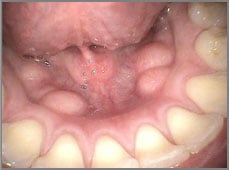Tori, often referred to as mouth bumps, are a common dental condition that can cause concern among those who discover them suddenly in their mouth. Despite their alarming discovery, tori are typically harmless, though they can sometimes lead to discomfort or concerns about oral health aesthetics. In this blog post, we’ll dive into what tori are, their causes, types, possible complications, and treatment options to clarify any misconceptions and provide valuable insights on this condition.
What Are Tori?
 Tori (singular: torus) are benign, bony growths that develop on the bones of the mouth. They are generally slow-growing and can vary in size. Most people with tori experience no symptoms and might not even realize they have them until highlighted during a dental examination. Tori are not cancerous and usually do not require treatment unless they interfere with oral functions or dental procedures.
Tori (singular: torus) are benign, bony growths that develop on the bones of the mouth. They are generally slow-growing and can vary in size. Most people with tori experience no symptoms and might not even realize they have them until highlighted during a dental examination. Tori are not cancerous and usually do not require treatment unless they interfere with oral functions or dental procedures.
Causes and Risk Factors
The exact cause of tori is not definitively known; however, several factors may contribute to their development:
- Genetics: There is often a hereditary component, with tori running in families.
- Bruxism: Clenching or grinding teeth can put extra pressure on the jaws, potentially leading to the formation of tori.
- Diet: Some research suggests a correlation between diets high in hard foods and the development of tori, possibly due to the increased jawbone use and pressure.
- Mineral Imbalance: Abnormal bone growth, including tori, can sometimes be linked to mineral imbalances within the body.
Types of Tori
There are primarily three types of tori, classified based on their location in the mouth:
- Torus Palatinus: This type appears on the roof of the mouth (the palate). It’s the most common form of tori and is usually symmetrical.
- Torus Mandibularis: These grow on the inner side of the lower jaw, near the premolars. They can appear on one or both sides.
- Buccal Exostoses: Less common, these are found on the outer side of the upper jaw.
Potential Complications
While tori are mostly benign, they can cause issues in specific scenarios:
- Oral Discomfort: Large tori might lead to irritation or discomfort while eating, speaking, or wearing dentures.
- Dental Hygiene Challenges: Tori can complicate brushing or flossing, leading to potential oral hygiene issues.
- Dental Procedure Interference: Significant tori might interfere with dentures fitting, dental implants, or other procedures.
Treatment and Management
For most individuals, tori do not require any treatment. However, in cases where tori lead to discomfort or interfere with dental work, surgical removal may be considered. The procedure is relatively straightforward but is recommended only when absolutely necessary due to potential complications and the risk of regrowth.
If you have tori and they are causing discomfort or concern, discuss them with your dentist. They can assess their size, growth, and impact to determine if any action is necessary. Additionally, your dentist can ensure that your oral hygiene routine is effective in managing around the tori and recommend changes or assistive devices to help.
Discovering bumps in your mouth can be startling, but understanding that tori are generally non-threatening can provide peace of mind. Through awareness and proper dental care, managing tori and maintaining oral health are entirely achievable goals. Always consult your dental professional if you have concerns about tori or any other oral health issues to receive personalized advice and care.
The bottom line is this: If your mouth looks like this, don’t panic. Simply see your dentist regularly to monitor the growth of the tori and the overall health of your mouth. To find a dentist near you, call (877) 880-1212.
Reviewed by: Diaa Ghabbour, DMD, MHS
Reviewed by: Cindy Roark, DMD
